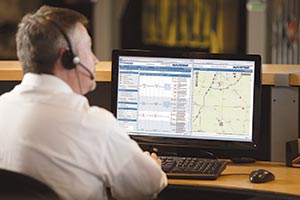Dealers Adjust to OEMs’ Diagnostics Systems by Revamping Service Center Operations

This story appears in the Jan. 19 print edition of Transport Topics.
Dealerships are updating service facilities and rethinking their management practices to keep pace with onboard remote diagnostics systems that truck makers offer to limit maintenance delays and get truckers back out on the road, industry representatives said.
“Uptime is key with the customers we talk to,” Göran Nyberg, Volvo Truck’s president of North American sales and marketing, said at a media event last month. Volvo offers a remote diagnostics product that connects to Volvo Group’s Uptime Center.
That focus among fleets — along with pressure from original equipment manufacturers — has required dealers to make changes, said Keith Ely of consulting firm KEA Advisors.
“Those that are adapting to it and perfecting it are seeing profitability like they have never seen before in the service department,” said Ely, who advises OEM dealerships and is conducting a workshop at this week’s annual convention of the American Truck Dealers in San Francisco.
Dealers are tracking “how fast did we push this repair order through the shop,” rather than just how many total hours of repair work were completed, he said.
Part of this push comes from OEMs, many of which demand that dealers conduct an initial assessment within two hours.
Those quick turnarounds can require modifications in how a shop is set up or how employees are deployed.
There also is more pressure on dealers to provide accurate time and cost estimates and to enhance communications with fleets during the repair process to avoid additional downtime.
The thinking behind parts ordering also is changing, Ely added. Traditionally, dealers would not restock certain parts that they rarely used. However, if that part could cause a driver extended downtime, dealers now are far more likely to keep it in stock, he said.
Ryan Young, general manager of Young Volvo, a part of Canton, Ohio-based Young Truck Sales Inc., agreed that dealers are changing many aspects of their service departments. For example, he said, they need to be able to react when notified by the manufacturer that a truck needing a minor repair or part replacement is on the way.
“There is no longer that long backlog,” Young said. “If it is something real quick and needs to get done in an hour — we need to be able to do it.”
That time saving also comes from manufacturers’ sending repair information or checking parts availability before even contacting the dealership, he said.
Navistar International Corp.’s product, known as OnCommand Connection, is an open-architecture system designed to work with nearly any telematics provider. Mike Cerilli, general manager of the vehicle-connected business, said the success of the system can be seen in many dealers’ shifting or hiring employees to become “OnCommand advocates,” responsible for monitoring vehicles and proactively advising fleets on regular maintenance or emergency fault codes.
Cerilli credited dealers for using the information from the system to build better relationships with customers to pro-actively reduce downtime when potential fault codes are triggered.
Last year, the company released a series of upgrades including integration with component suppliers, starting with engine maker Cummins Inc. At that time, Cerilli stated that one fleet had “recently experienced a 28% reduction in down days and a 31% reduction in repairs by leveraging the vehicle health reports and repair recommendation data.”
Bill Kozek, Navistar’s president of North American trucks and parts, said last month that OnCommand Connection was further helping dealers by boosting used-truck sales.
The system is offered as part of the Diamond Renewed program, which launched last summer. The program certifies 2010 or newer ProStar, TranStar and LoneStar vehicles with a MaxxForce exhaust gas recirculation engine with fewer than 400,000 miles.
Daimler Trucks North America was among the first to offer a remote diagnostics system, Virtual Technician, in 2011. Developed with Zonar Systems, the system transmits engine diagnostics to staff at a customer support center, which then communicates with fleets and can help schedule service and verify the parts are available.
It also notifies the service center of the inbound truck, including the pre-diagnosis.
Mary Aufdemberg, director of product marketing for Freightliner Trucks, said Virtual Technician and the Detroit Assurance suite of products allow “customers to interact more smoothly and efficiently with DTNA’s network of retail centers.”
Since 2011, Virtual Technician has assisted more than 13,000 customers with service recommendations, DTNA said.
Truck dealership chain Rush Enterprises sells Peterbilt and International heavy-duty trucks. It is “investing a lot of money right now” in predictive diagnostics and telematics, Chairman and CEO Rusty Rush said.
He said the information helps the company’s service shops with “understanding [the] needs of customers” and that improved service “drives the truck sales.”
Similarly, dealer principal Craig Young said technology is helping in other areas of Young Truck Sales, which includes Young Volvo, and Young Freightliner and Isuzu.
The dealer group is seeing more leasing interest for trucks with more modern technology, he said. In some cases, customers simply want to see demonstrations, he added, but having the vehicles available can help customers see how they can monitor a truck’s performance from an office computer.
Young also said that remote diagnostics can help with automated tracking of repair work and ensure dealers are properly compensated for all warranty work.
The Young dealership group is undergoing a multimillion-dollar investment to expand the service department. Besides having built a dedicated natural-gas maintenance facility, it’s increasing overall capacity by 100% and extending service hours, providing more truckers traveling near Interstate 77 a chance to get serviced and back on the road more quickly.
Overall, Volvo Trucks said its dealers across North America invested $400 million in service facilities from 2010 through the third quarter of 2014, including more than 50 new or renovated facilities and 25 more that were planned or under way. Mack Trucks, also part of Volvo Group, reports a similar level of investment, resulting in at least 35% more service-bay capacity, a 69% jump in spare-parts availability and a 62% bump in hours available for service.
During 2014, Volvo and Mack each announced partnerships with telematics provider Telogis to offer fleet-management services that utilize built-in telematics hardware.
In an effort to make their trucks what Nyberg called “the most productive in the industry,” the companies jointly opened the Uptime Center late last year in Greensboro, North Carolina.
The dedicated center monitors trucks and coordinates communications among drivers, fleets and dealers. One area of the Uptime Center is devoted to dealers,
providing them assistance including technical guidance and information on warranty claims.
“Integrating technology and services facilitates customer choice and offers them the best return on investment,” said Stephen Roy, Mack’s president of North American sales and marketing.
John Walsh, Mack’s vice president of marketing, said the company is planning upgrades to its GuardDog Connect telematics offering this year.
At work behind the scenes at the Uptime Center is Decisiv Inc.’s service relationship management platform, said Michael Riemer, Decisiv’s vice president of products.
The company works with OEMs, as well as fleets and independent providers.
For dealers, Riemer said, the technology offers savings too significant to ignore. Rather than spending as much as one hour checking in a truck, looking up its history, providing an initial inspection and creating a work order, technologies offered from companies such as Decisiv can cut it to 10 minutes.
Dealers often see another major benefit.
“When we talk to service providers, one of the biggest pain points are mismatched estimates and invoices,” he said. “This offers great value to dealers that sometimes they forget about.”


